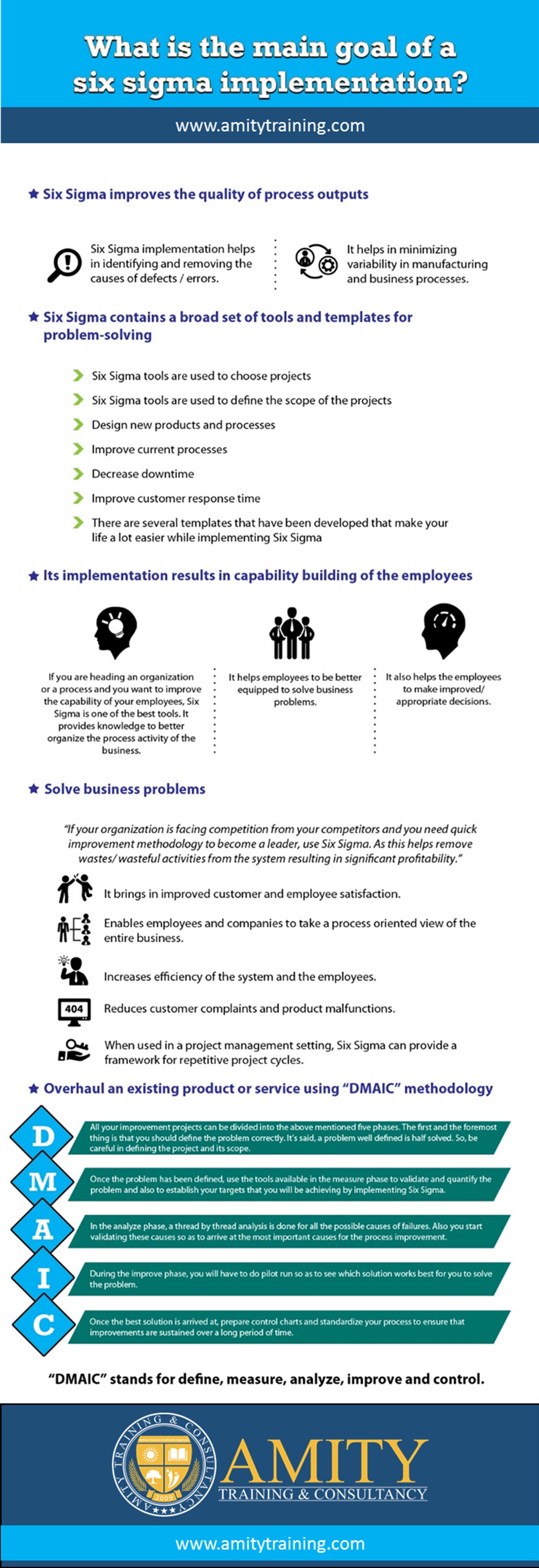What is the main goal of a six sigma implementation ?
What is the main goal of a six sigma implementation ? You guessed it right, the main goal of Six Sigma implementation is continuous improvement. But you may be thinking how does Six Sigma implementation brings in continuous improvement.
Let’s have look at this case study. This is a case study of Tom who is always late for the office.
Now let’s have a look at this easy to understand infographics of What is the main goal of a six sigma implementation?

Get this “What is the main goal of a six sigma implementation” Infographics
Transcript of “What is the main goal of a six sigma implementation”?
Six Sigma improves the quality of process outputs
- Six Sigma implementation helps in identifying and removing the causes of defects / errors
- It helps in minimizing variability in manufacturing and business processes
Six Sigma contains a broad set of tools and templates for problem-solving
- Six Sigma tools are used to choose projects
- Six Sigma tools are used to define the scope of the projects
- Design new products and processes
- Improve current processes
- Decrease downtime
- Improve customer response time
- There are several templates that have been developed that make your life a lot easier while implementing Six Sigma
Its implementation results in capability building of the employees
- If you are heading an organization or a process and you want to improve the capability of your employees, Six Sigma is one of the best tools. It provides knowledge to better organize the process activity of the business
- It helps employees to be better equipped to solve business problems
- It also helps the employees to make improved/appropriate decisions
Solve business problems
- If your organization is facing competition from your competitors and you need quick improvement methodology to become a leader, use Six Sigma. As this helps remove wastes/ wasteful activities from the system resulting in significant profitability
- It brings in improved customer and employee satisfaction.
- Enables employees and companies to take a process oriented view of the entire business
- Increases efficiency of the system and the employees
- Reduces customer complaints and product malfunctions
- When used in a project management setting, Six Sigma can provide a framework for repetitive project cycles
Overhaul an existing product or service using “DMAIC” methodology
- “DMAIC” stands for define, measure, analyze, improve and control
- All your improvement projects can be divided into the above mentioned five phases. The first and the foremost thing is that you should define the problem correctly. It’s said, a problem well defined is half solved. So, be careful in defining the project and its scope
- Once the problem has been defined, use the tools available in the measure phase to validate and quantify the problem and also to establish your targets that you will be achieving by implementing Six Sigma
- In the analyze phase, a thread by thread analysis is done for all the possible causes of failures. Also you start validating these causes so as to arrive at the most important causes for the process improvement
- During the improve phase, you will have to do pilot run so as to see which solution works best for you to solve the problem
- Once the best solution is arrived at, prepare control charts and standardize your process to ensure that improvements are sustained over a long period of time
So, what to do next?
Having understood what is the main goal of a six sigma implementation, why not attend any Lean Six Sigma Course. We offer both
- FREE Lean Six Sigma Training
- Online Live Instructor Led Training (Enroll now for any of the upcoming programs)







